RARE! Original WWII March 1945 Battle of Remagen Ludendorff Bridge "After Action" Rhine River U.S. Intelligence Sketch Map
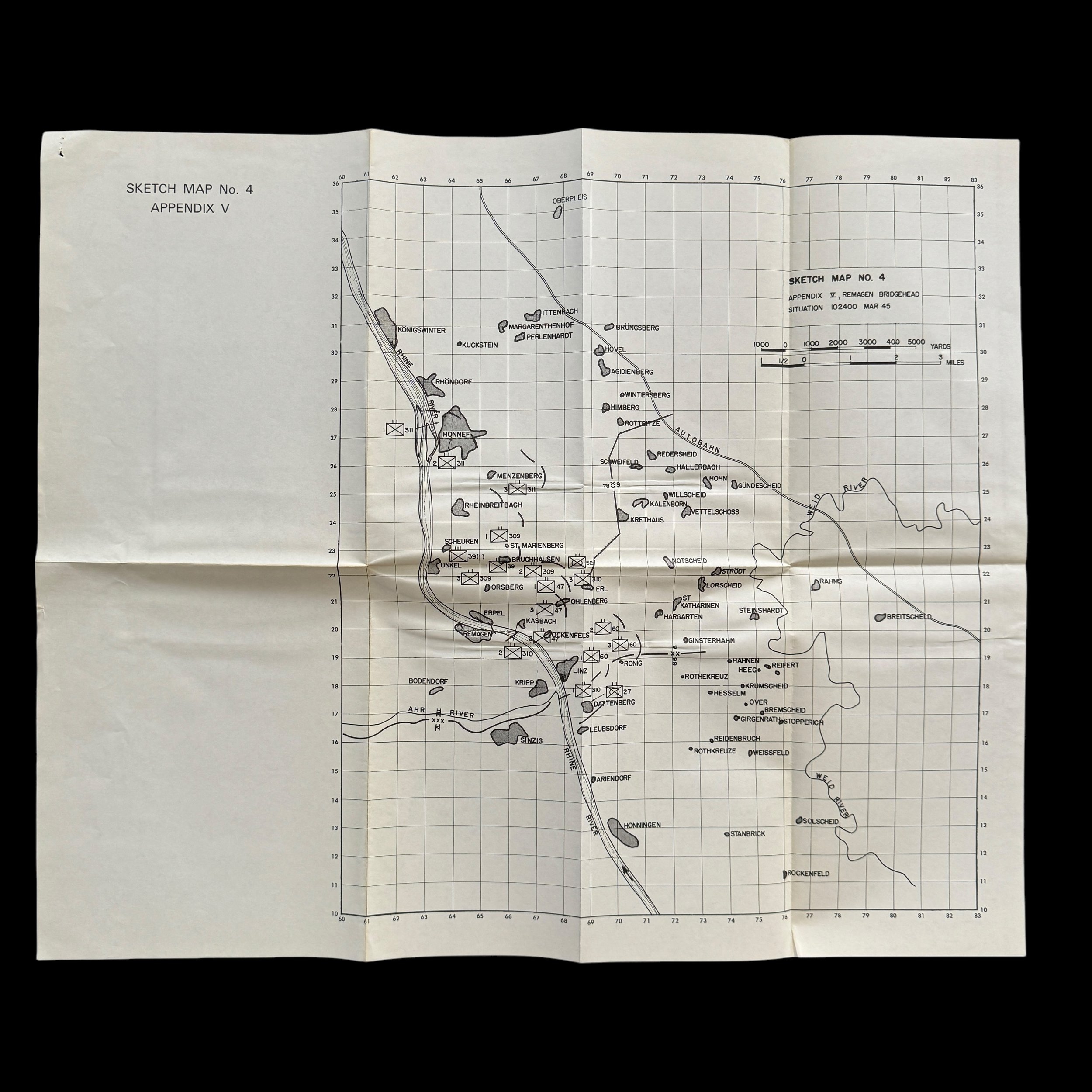
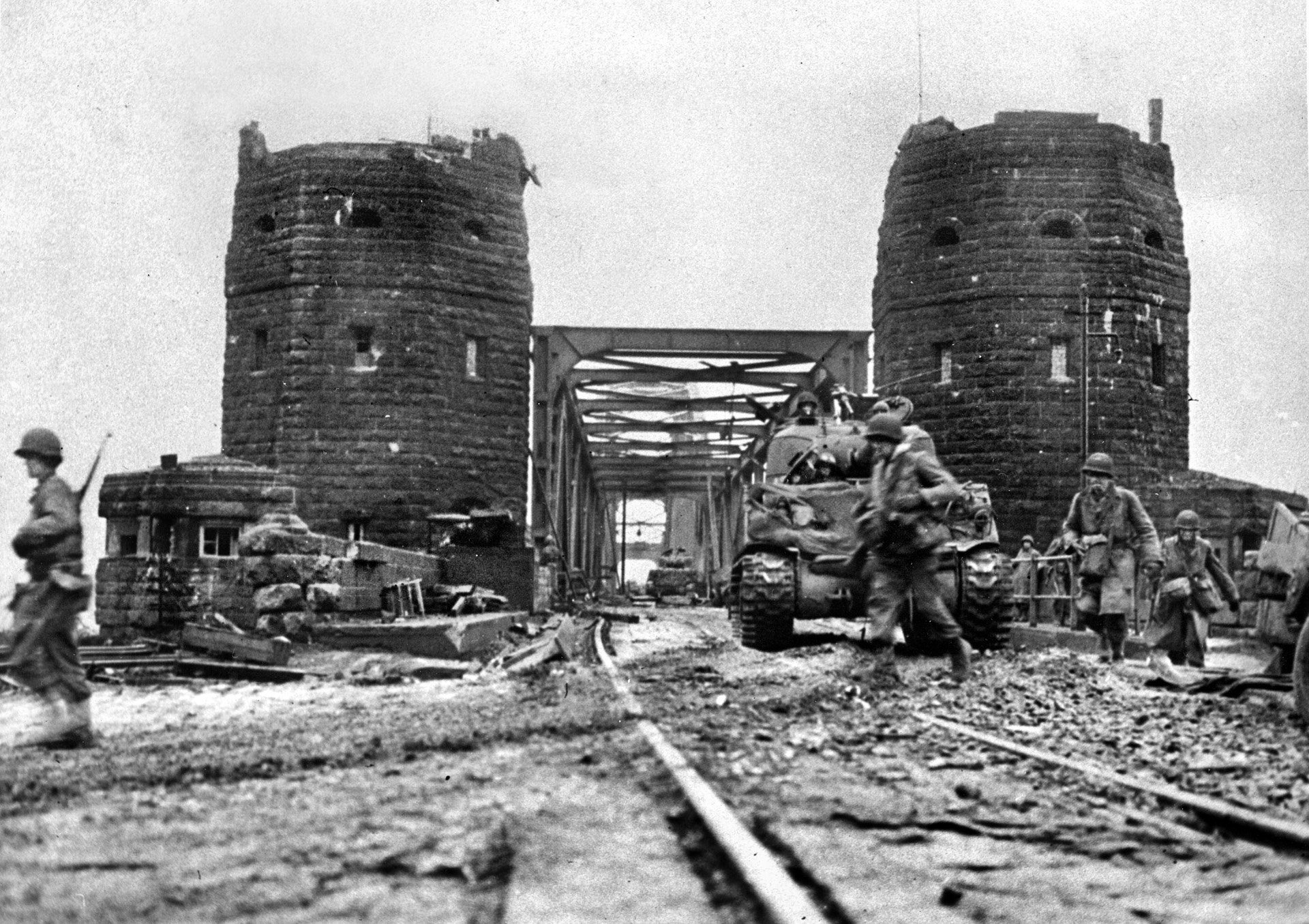
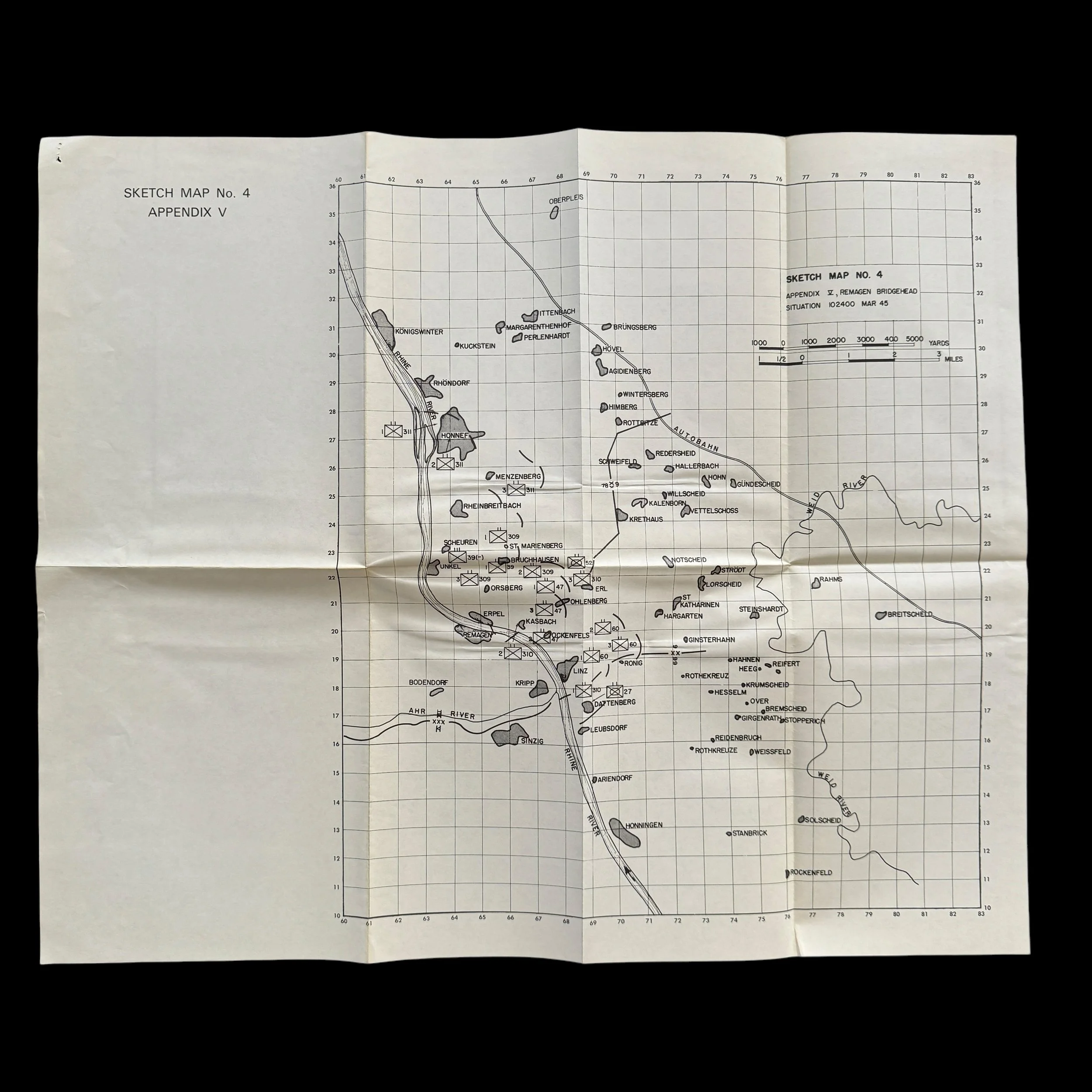

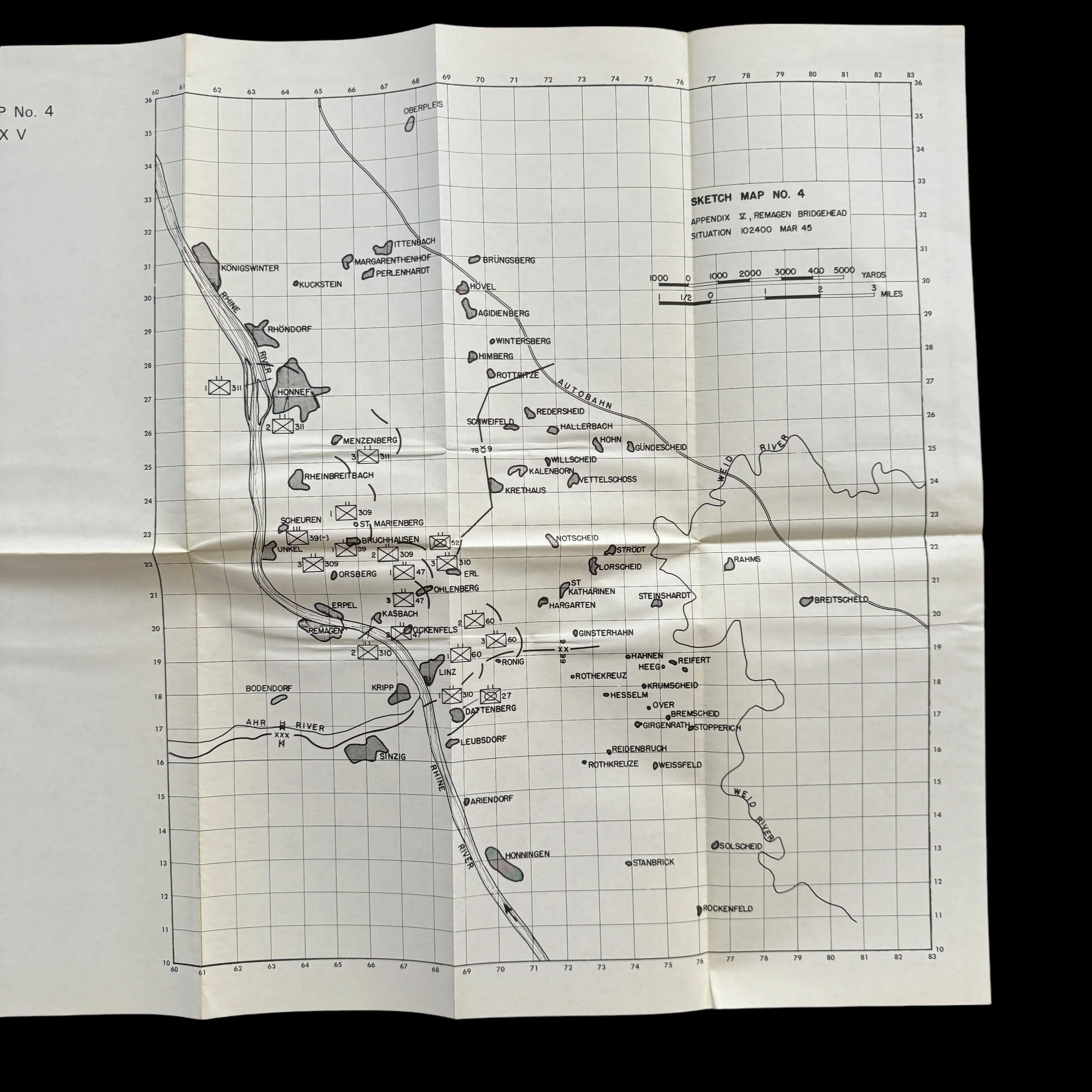

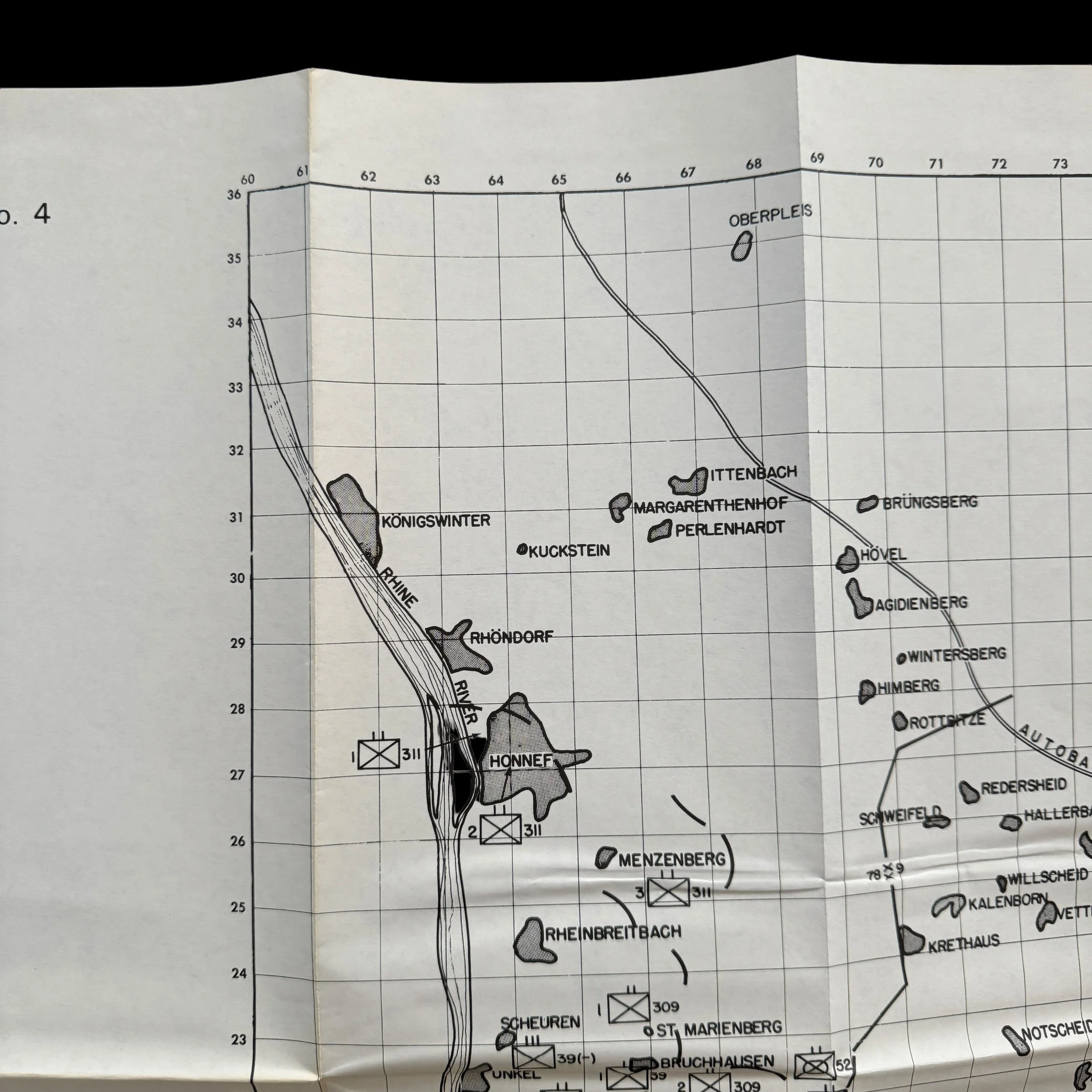

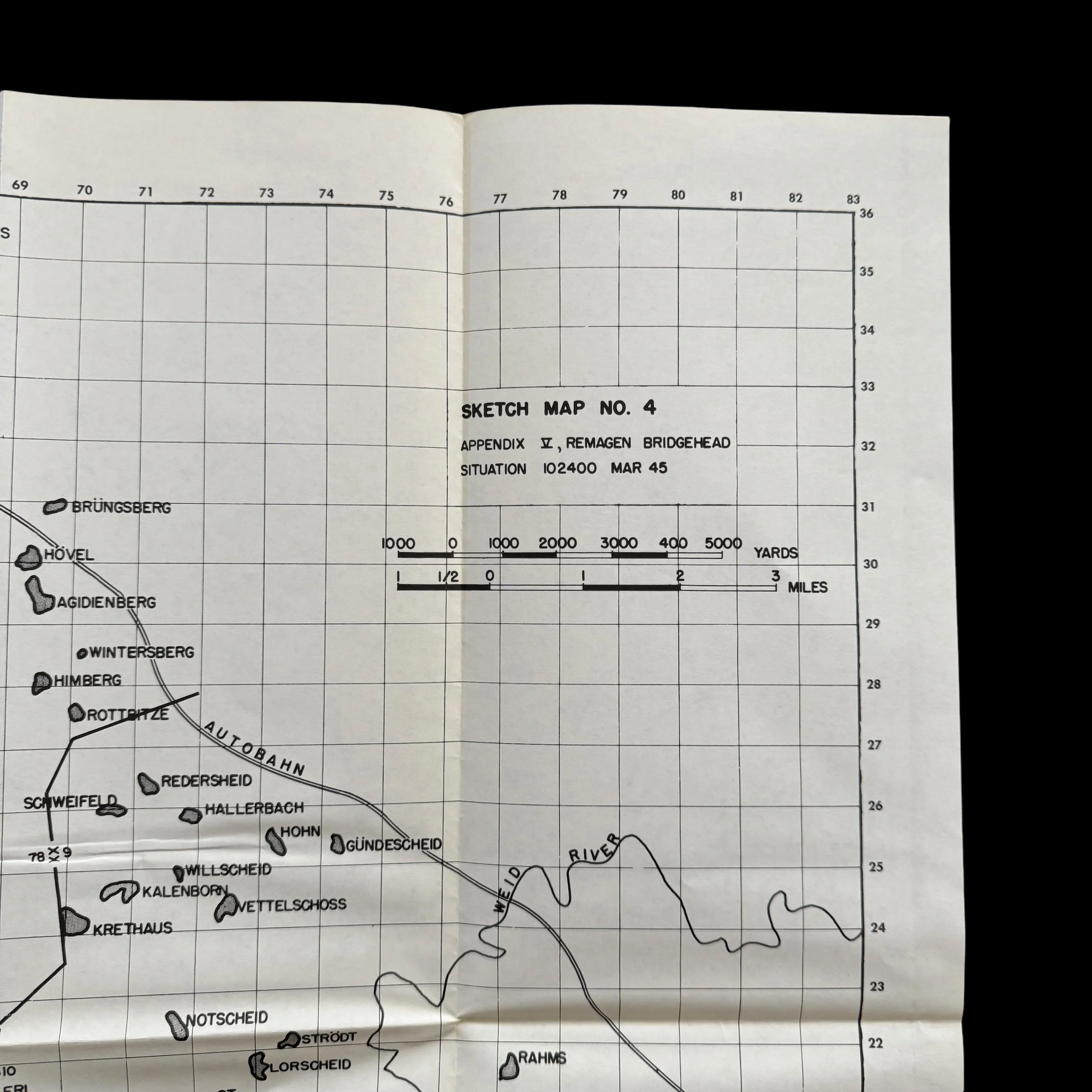
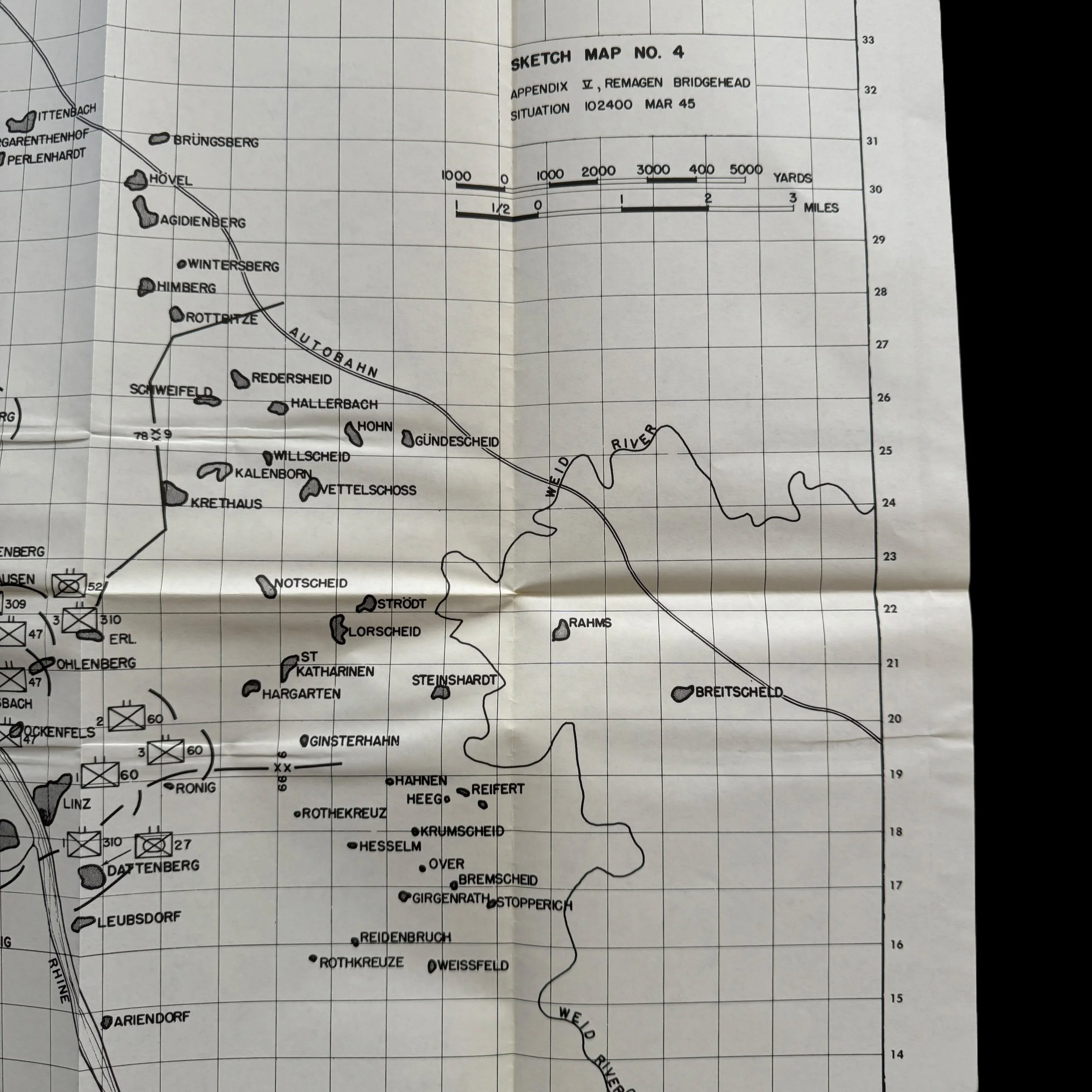
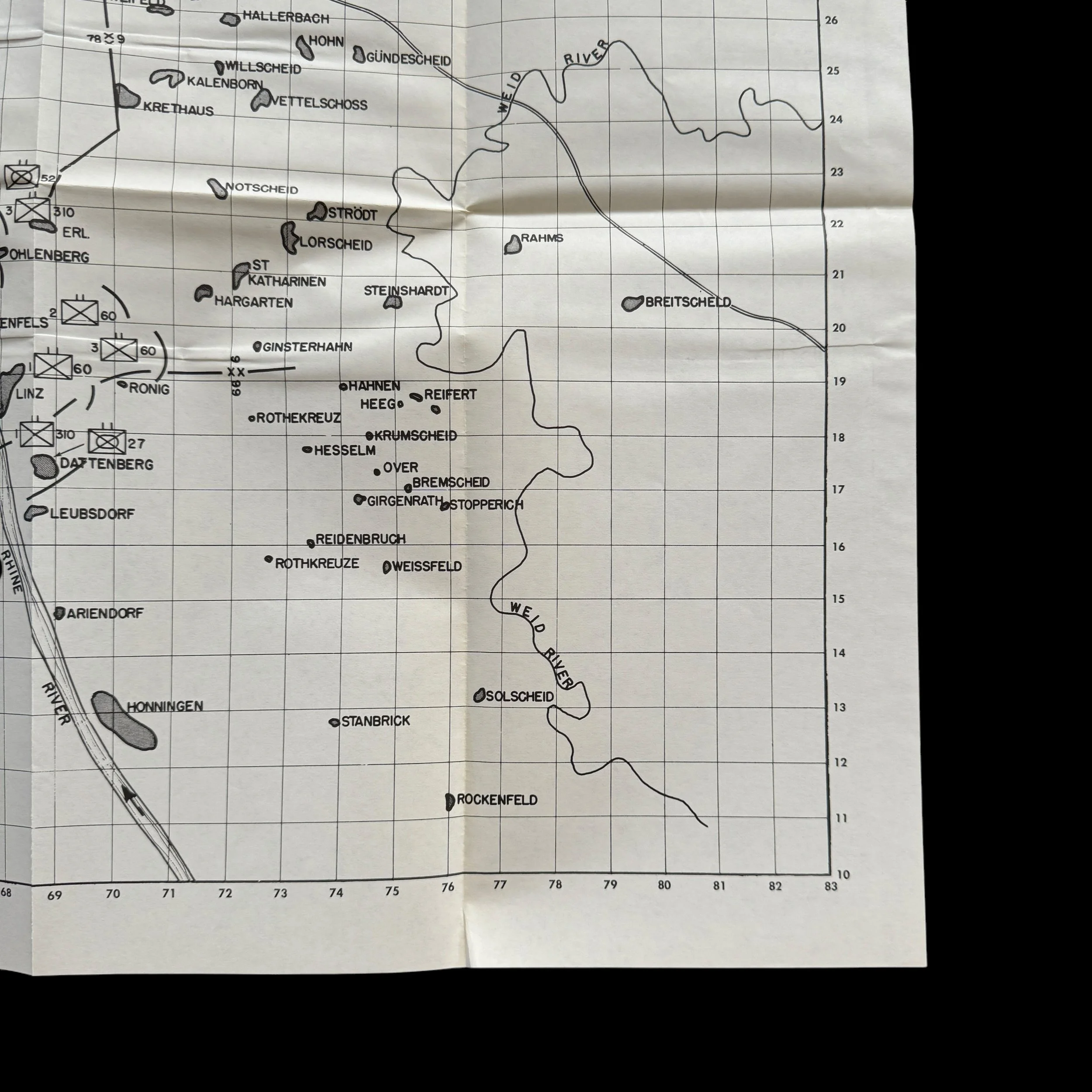
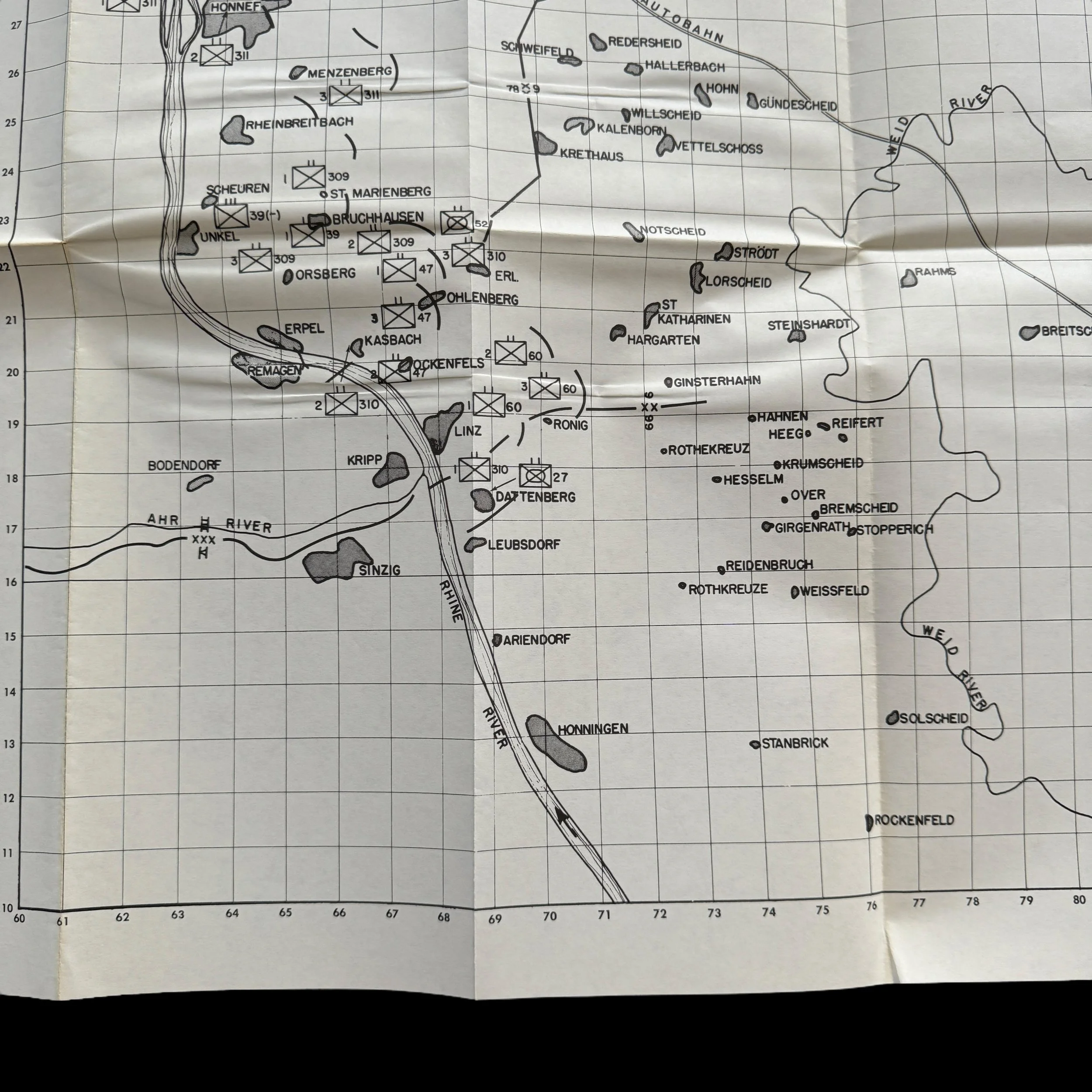
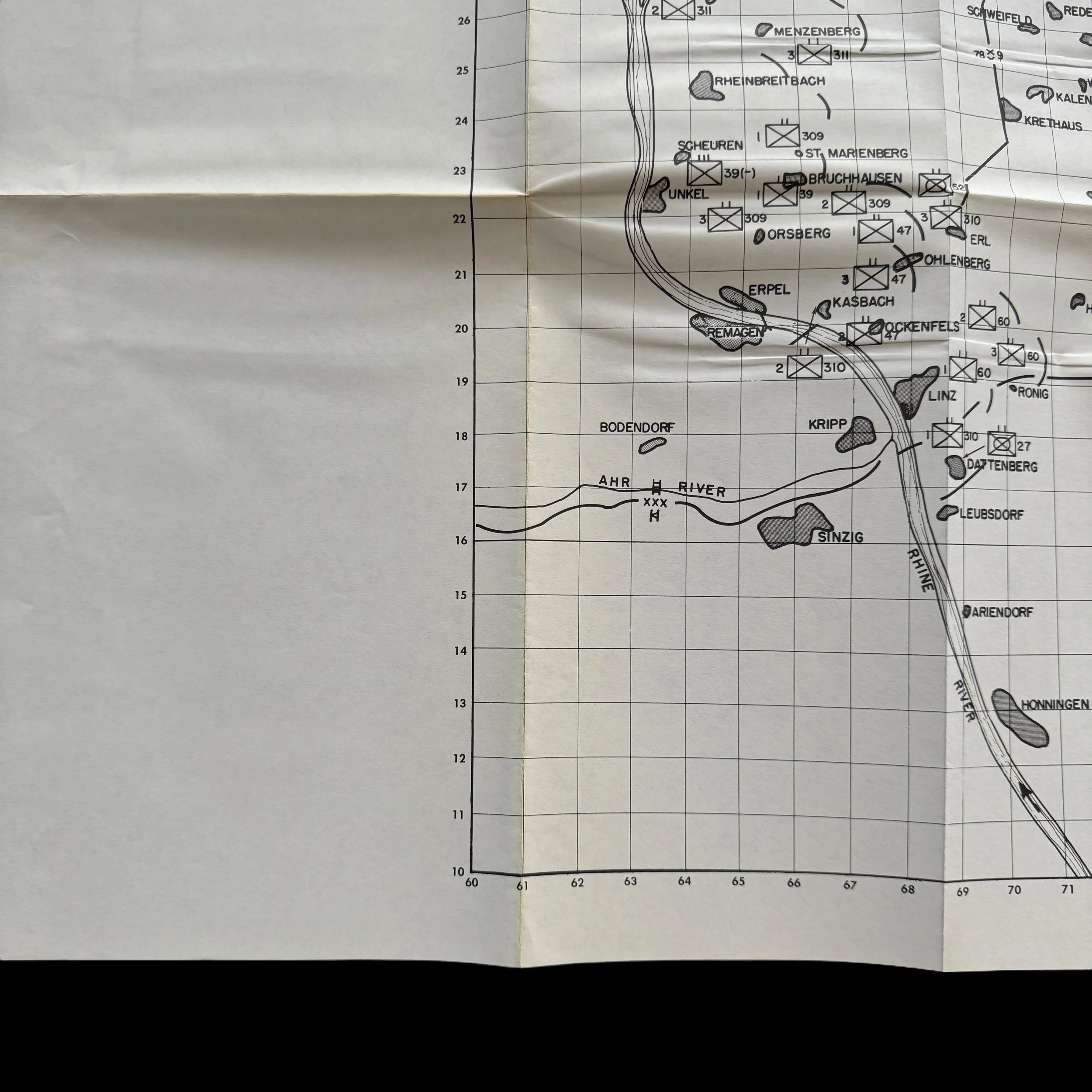
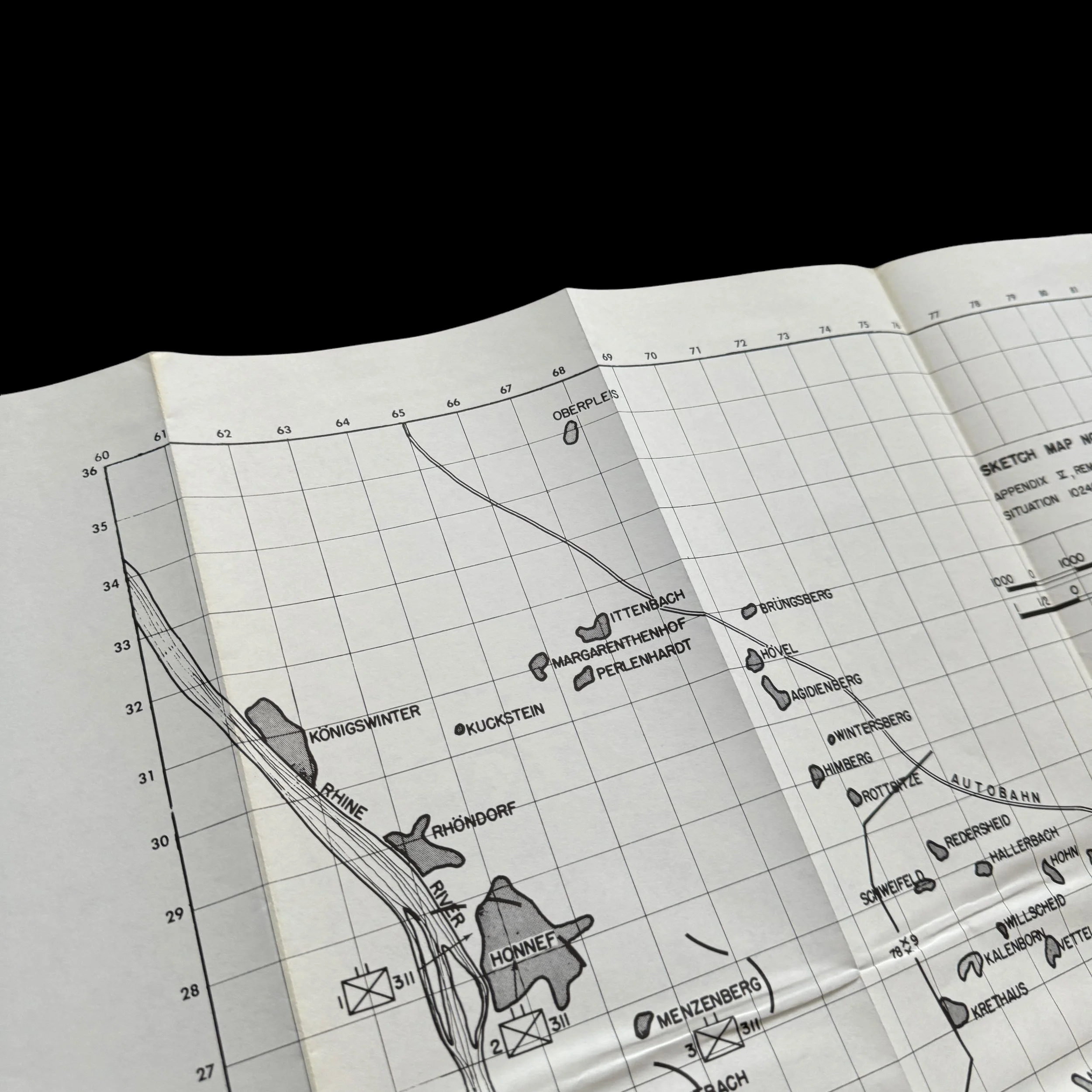
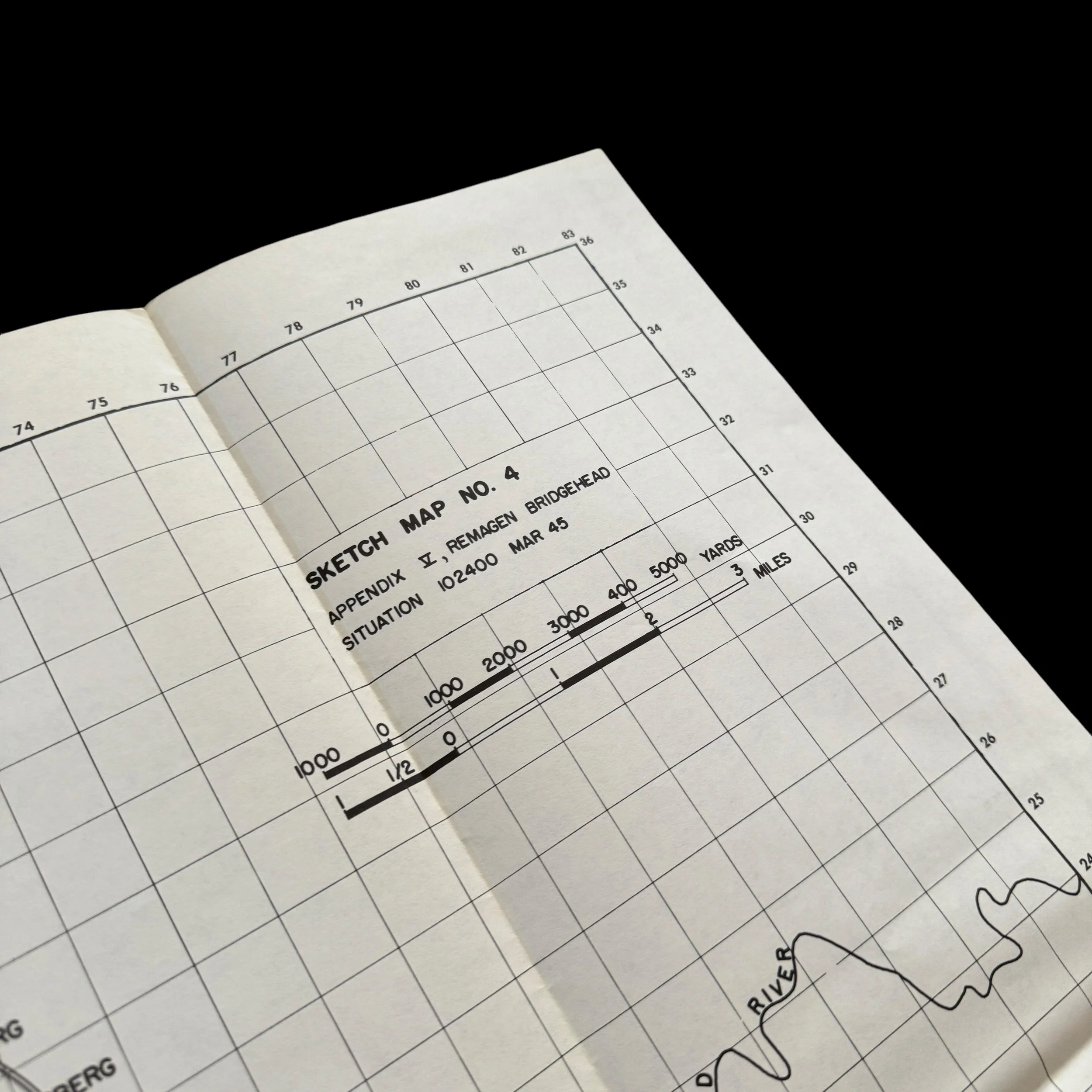
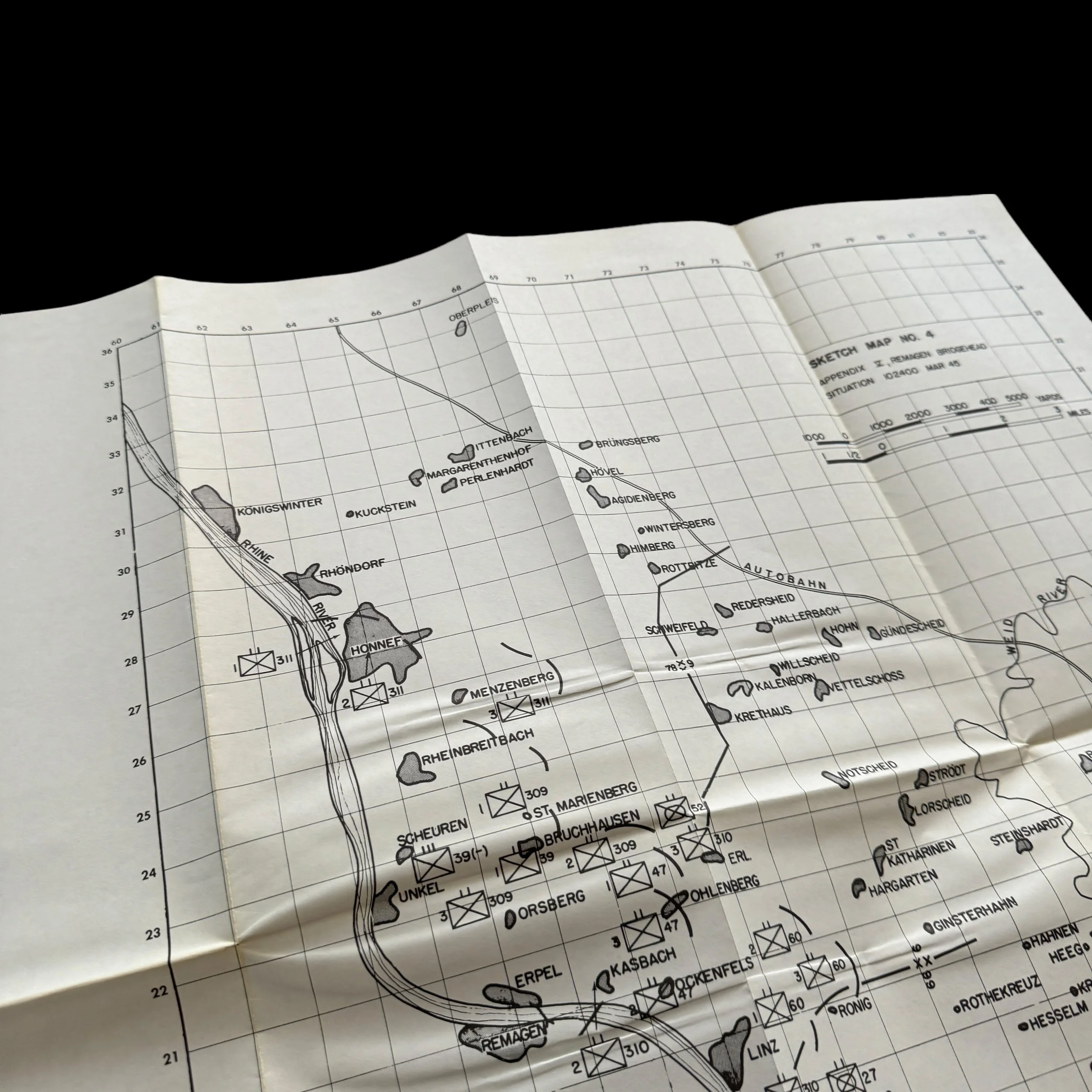
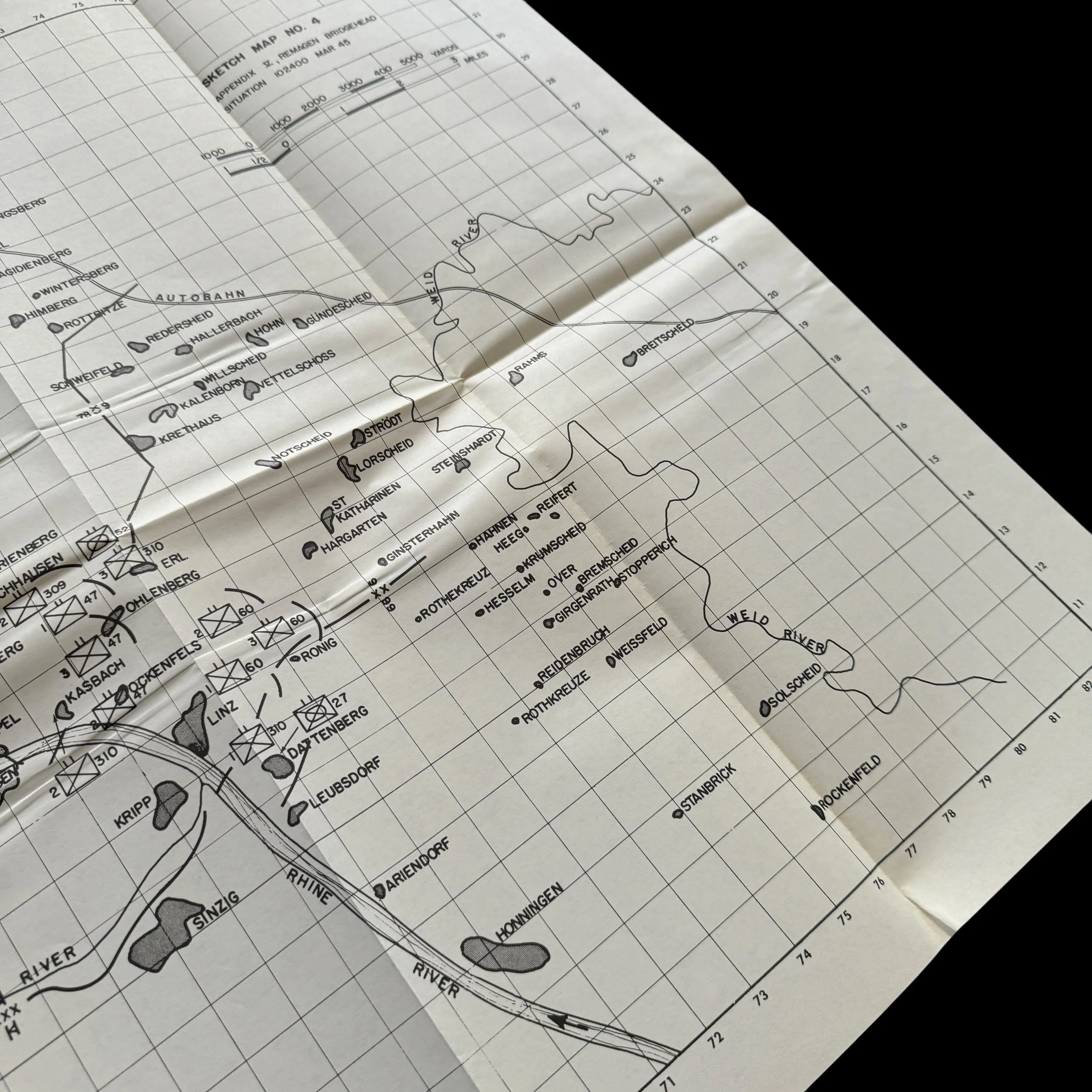
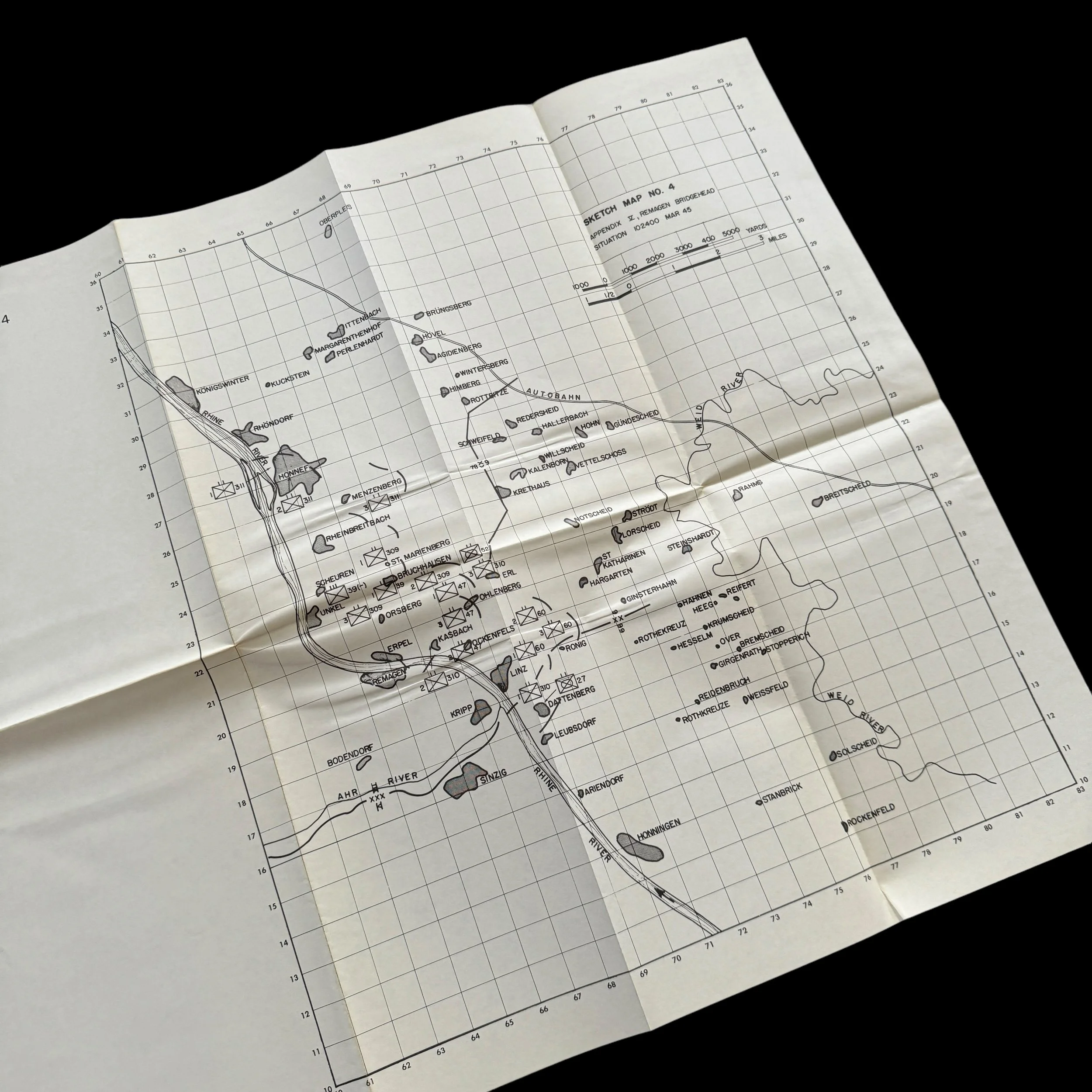
RARE! Original WWII March 1945 Battle of Remagen Ludendorff Bridge "After Action" Rhine River U.S. Intelligence Sketch Map
Comes with a hand-signed C.O.A.
*SHOWS THE SITUATION OF REMAGEN BRIDGEHEAD AS OF MARCH 1945.
This rare and museum-grade WWII artifact is an original "after action" Battle of Remagen intelligence sketch map of the capture of the Ludendorff Bridge at Remagen.
Following significant military engagements during World War II, such as the capture of the Ludendorff Bridge at Remagen and the subsequent establishment of the Remagen Bridgehead across the Rhine River, detailed after-action reports were crucial for evaluating the success and challenges of the operation. One of the most valuable tools for these reports were after-action sketch maps, which were made for officers and high-ranking military officials. These maps provided a visual and tactical representation of the events that had transpired during the battle, offering insights into the positioning of troops, the terrain, and the strategic maneuvers that had been executed.
In the case of the Battle of Remagen and the crossing of the Rhine River, after-action sketch maps played a significant role in documenting how the U.S. forces were able to seize the Ludendorff Bridge, establish a bridgehead, and secure the eastern bank of the Rhine despite fierce German resistance. These maps were not only historical records but also critical tools for military planning, analysis, and future operations.
Purpose of After-Action Sketch Maps
The primary purpose of after-action sketch maps was to provide a clear and detailed representation of how the battle unfolded. They served several key functions:
Post-Battle Analysis and Review:After a major operation like the assault on the Ludendorff Bridge, military leaders needed to review the decisions made during the battle and assess their effectiveness. Sketch maps allowed officers and strategists to visualize the movement of forces in relation to the terrain and enemy positions. By illustrating how the U.S. forces approached and secured the bridge, established the Remagen Bridgehead, and dealt with German counterattacks, these maps helped pinpoint both successes and failures. For example, the maps could highlight areas where the attack had stalled or where defenses had been particularly effective.
This review process was critical for the improvement of future operations. Lessons learned from the Battle of Remagen would inform later crossings of the Rhine and other riverine assaults. Military planners could study the maps to understand the challenges posed by the river’s terrain, enemy fortifications, and logistical issues such as the repair and use of the damaged bridge.
Coordination and Communication Among Commanders:High-ranking military officials needed a clear and concise way to understand what had transpired on the battlefield. The chaos of war often made real-time communication difficult, and different units might experience very different aspects of a single battle. After-action sketch maps provided a way to condense complex battlefield information into a format that could be easily communicated among military leadership.
For instance, commanders would use these maps during briefings to explain the positioning of forces, the timeline of events, and how different units interacted. The maps allowed leaders to coordinate more effectively by giving them a shared visual reference point. They could quickly grasp the spatial relationships between friendly and enemy forces, facilitating discussions about strategy, tactics, and logistics.
Documentation for Historical Records and Military Archives:After-action sketch maps also played a vital role in documenting military history. These maps were often preserved as part of the official records of an operation, contributing to the overall historical understanding of the battle. They served as primary sources for historians, providing a snapshot of the battlefield as it appeared at a specific moment in time.
In the case of the Remagen Bridgehead, these maps would later be used to illustrate how the first intact bridge over the Rhine was captured and how the Allies established a critical foothold on the eastern side of the river. Military historians could study the maps to gain insights into the tactical decisions made by U.S. commanders, the challenges faced by the troops on the ground, and the effectiveness of the German defenses.
Tactical and Strategic Planning for Future Operations:The seizure of the Ludendorff Bridge and the establishment of the Remagen Bridgehead were of great significance because they represented the first successful crossing of the Rhine by Allied forces. After-action sketch maps were invaluable for planning future operations, as they provided insights into how to conduct large-scale river assaults, which were among the most complex military operations.
For military planners, these maps demonstrated how U.S. forces approached the river, secured the bridge, and expanded their foothold on the opposite bank. Future commanders could use these maps to anticipate similar challenges and devise strategies to overcome them. This was especially important as the Allies planned additional crossings of the Rhine at other locations, where they would face similar terrain and defensive measures.
Features of After-Action Sketch Maps from Remagen
The after-action sketch maps created following the Battle of Remagen contained several key features that made them particularly useful to military officials:
Topographical Details:The maps would have depicted the terrain surrounding the Ludendorff Bridge, including the Rhine River itself, the elevation changes on both banks, and key landmarks such as hills, roads, and towns. Understanding the topography was essential for evaluating how the U.S. forces approached the bridge and how the Germans had positioned their defenses.
Troop Movements and Unit Positions:These maps showed the positions of both Allied and German forces throughout the battle. Arrows and symbols would have indicated the direction of troop movements, showing where U.S. forces advanced, where German counterattacks were launched, and how both sides maneuvered for advantage. Key unit designations would have been marked, allowing officers to understand which divisions or regiments were engaged in specific parts of the battle.
Bridge and Defensive Structures:Given the centrality of the Ludendorff Bridge in the battle, the after-action maps would have provided detailed depictions of the bridge itself, including the locations of German demolition charges, anti-aircraft guns, and fortifications. This information was crucial for understanding how U.S. engineers worked to neutralize the demolition threat and repair the damaged bridge.
Timeline of Events:Some after-action sketch maps incorporated a timeline of key events during the battle, such as the time when the bridge was first sighted, when demolition attempts were made, and when U.S. forces successfully crossed the bridge. This chronological detail helped officers and planners understand how the battle unfolded in real time.
Enemy Fortifications and Artillery Positions:The maps would have included details about the German defenses on both sides of the Rhine, including the location of artillery batteries, machine gun nests, and anti-tank obstacles. This information was crucial for understanding how U.S. forces overcame the German defenses and where the heaviest resistance was encountered.
The Broader Impact of After-Action Reports and Sketch Maps
The after-action sketch maps created during the Battle of Remagen, like those of other major engagements during World War II, played an essential role in both the short-term and long-term success of the Allied campaign. In the short term, they allowed military officials to assess the effectiveness of the Remagen operation, understand the dynamics of the battle, and make adjustments to tactics and strategies as the Allies continued their advance into Germany. In the long term, these maps became critical tools for historians and military scholars studying the war, providing a visual representation of one of the key moments in the final stages of the European theater.
Furthermore, the rapid capture of the Ludendorff Bridge and the establishment of the Remagen Bridgehead demonstrated the importance of quick thinking, flexibility, and seizing unexpected opportunities in warfare. The maps from this operation provided future military leaders with lessons about how to successfully conduct complex river crossings, deal with well-fortified enemy positions, and adapt to changing battlefield conditions.
After-action sketch maps of the Remagen Bridgehead were invaluable tools for military officers and high-ranking officials, serving as a means of analyzing the battle, coordinating among commanders, documenting history, and planning future operations. The Battle of Remagen was a critical moment in the Allied campaign to defeat Germany, and the detailed maps created in the aftermath of the battle helped to ensure that the lessons learned from this engagement would be preserved and applied to future operations. Through these maps, military leaders were able to gain a clearer understanding of the complexities of the battle, while historians and future generations could look back on the significance of the Rhine River assault and the bridgehead that followed.
___________________________________
The Battle of Remagen: Securing the Rhine River and the Remagen Bridgehead
The Battle of Remagen, fought in March 1945 during the final months of World War II, was a pivotal moment in the Allies' campaign to defeat Germany. It centered around the Ludendorff Bridge at Remagen, a crucial crossing over the Rhine River that offered the Allies an unexpected opportunity to establish a bridgehead deep into Germany’s heartland. The seizure of the bridge and the subsequent creation of the Remagen Bridgehead not only expedited the Allies’ push into Germany but also symbolized the inevitable collapse of the Third Reich.
Strategic Importance of the Rhine River
The Rhine River, one of Europe's longest and most significant rivers, has played a critical role in shaping the history of the continent. During World War II, the Rhine formed a formidable natural barrier between Germany and the advancing Allied forces. The river represented the last major geographical obstacle preventing the Allies from reaching the heart of Germany and was a key part of the German defensive line. Throughout history, military leaders had viewed the Rhine as a natural bulwark that could slow or stop invading armies. Thus, the crossing of the Rhine became a strategic priority for the Allies in the closing months of the war.
By early 1945, the Allies had already advanced far into Western Europe following their successful campaigns in France and Belgium. After the Battle of the Bulge in December 1944, the last major German counteroffensive in the West, the German military was in retreat. The Rhine River became the next focus for the Allies, who were determined to breach this last natural defense and push into the industrial heart of Germany, the Ruhr Valley. Securing a crossing over the Rhine would allow the Allies to encircle and capture the remaining German forces and bring the war to a swift conclusion.
The Ludendorff Bridge at Remagen
The Ludendorff Bridge, located at the town of Remagen in western Germany, was a strategic structure built during World War I to facilitate troop movements. The bridge spanned the Rhine River and connected the small town of Remagen on the west bank with Erpel on the east bank. By March 1945, the bridge was one of the few remaining intact bridges over the Rhine, as many had been destroyed by German forces in an attempt to slow the Allied advance.
The Ludendorff Bridge was particularly significant because it provided a direct route into Germany, bypassing other heavily fortified areas along the Rhine. The German High Command had issued orders for all Rhine bridges to be destroyed to prevent the Allies from crossing the river. However, for reasons that remain somewhat unclear—whether due to confusion, miscommunication, or technical difficulties—the Ludendorff Bridge remained standing, and this unexpected opportunity would soon become a major turning point in the Allied campaign.
The Discovery and Capture of the Ludendorff Bridge
On March 7, 1945, elements of the U.S. 9th Armored Division, part of the First U.S. Army under the command of General Courtney Hodges, were advancing toward the Rhine when they reached the town of Remagen. The Americans were not expecting to find any intact bridges, but to their surprise, reconnaissance units reported that the Ludendorff Bridge was still standing.
Initially, the U.S. forces had no specific orders to capture the bridge, as it was widely assumed that the Germans would destroy it before it could be seized. However, realizing the opportunity that lay before them, Brigadier General William M. Hoge, commander of the Combat Command B of the 9th Armored Division, made a bold decision to capture the bridge before the Germans could destroy it.
The Germans had placed explosives on the bridge, intending to destroy it as the Americans approached. However, in the chaos of battle, the German engineers failed to detonate the charges effectively. Several attempts to blow the bridge were either unsuccessful or only partially damaged the structure. The Americans, seeing their chance, quickly advanced under heavy fire to secure the bridge.
Led by Lieutenant Karl H. Timmermann, the U.S. infantrymen and engineers stormed the bridge, braving small arms fire, artillery, and attempts by German forces to destroy the structure. Timmermann’s bravery, along with that of his fellow soldiers, allowed the U.S. forces to establish a bridgehead on the eastern bank of the Rhine. By the afternoon of March 7, the Ludendorff Bridge was in Allied hands, marking the first time that an intact bridge over the Rhine had been captured by the Allies during the war.
The Remagen Bridgehead
The capture of the Ludendorff Bridge was a stunning strategic victory for the Allies. It allowed them to immediately begin ferrying troops, vehicles, and supplies across the Rhine, creating what became known as the Remagen Bridgehead. The bridgehead quickly became a crucial point of Allied operations, enabling the rapid buildup of forces on the eastern side of the Rhine.
In the days following the capture of the bridge, the U.S. Army moved swiftly to consolidate its position. Engineers worked around the clock to repair the damage to the Ludendorff Bridge and build additional pontoon bridges to support the flow of men and materiel. Within 24 hours, thousands of U.S. troops and dozens of tanks had crossed the Rhine, establishing a foothold in Germany’s interior. The speed of the Allied response was critical, as German forces in the area, under Field Marshal Albert Kesselring, scrambled to mount a counterattack.
The Germans understood the significance of the Allies’ crossing of the Rhine and launched a series of desperate counterattacks to destroy the bridge and contain the Allied advance. Over the next several days, German artillery, aircraft, and even frogmen were employed in attempts to destroy the Ludendorff Bridge and halt the Allies’ momentum. The Luftwaffe launched numerous air raids, including attacks by the newly developed jet-propelled Me 262 fighters and V-2 rockets, but these efforts were ultimately unsuccessful.
Despite heavy German resistance, the Americans continued to strengthen their position. The capture of the bridge and the rapid establishment of the bridgehead allowed the U.S. forces to expand their presence on the eastern bank of the Rhine, positioning themselves for further advances into Germany.
The Collapse of the Ludendorff Bridge
Unfortunately, the Ludendorff Bridge was severely damaged by repeated German attacks and the strain of heavy Allied traffic. On March 17, 1945, just ten days after its capture, the bridge collapsed into the Rhine, killing 28 U.S. engineers who were attempting to reinforce it at the time. Despite the loss of the bridge, the Allies had already established multiple pontoon bridges and had built a strong bridgehead, allowing them to continue their advance into Germany unimpeded.
The collapse of the bridge did not halt the Allied offensive, which had gained unstoppable momentum. The successful crossing of the Rhine at Remagen allowed the Allies to pour troops and equipment into Germany and begin the encirclement of the Ruhr Valley, Germany’s industrial heartland. Within weeks, the Allies were able to link up with other forces advancing from different directions, cutting off German forces and hastening the collapse of the German regime.
Strategic and Psychological Impact of the Battle of Remagen
The Battle of Remagen and the capture of the Ludendorff Bridge had both strategic and psychological impacts on the course of the war. Strategically, the capture of the bridge allowed the Allies to cross the Rhine weeks earlier than expected, speeding up their advance into Germany and accelerating the fall of the Third Reich. The bridgehead at Remagen became a vital entry point into central Germany, from which the Allies launched offensives that would ultimately lead to the encirclement and destruction of the German Army Group B in the Ruhr Pocket.
The psychological impact of the bridge’s capture was equally significant. The sight of American troops crossing the Rhine, a river that had long been regarded as an impregnable barrier, sent shockwaves through both the Allied and Axis forces. For the Allies, it was a symbol of their unstoppable advance into Germany, reinforcing the belief that victory was within reach. For the Germans, the loss of the bridge was a demoralizing blow, signifying that their last line of defense had been breached and that defeat was inevitable.
The Battle of Remagen and the capture of the Ludendorff Bridge stand as one of the defining moments of the Allied campaign in Europe during World War II. The successful seizure of the bridge and the establishment of the Remagen Bridgehead marked the beginning of the final Allied push into Germany, hastening the end of the war. The battle exemplified the importance of quick decision-making, bold action, and the ability to seize opportunities in the chaos of war. For the soldiers who fought and died at Remagen, their courage and determination played a critical role in bringing about the defeat of Germany and the liberation of Europe.